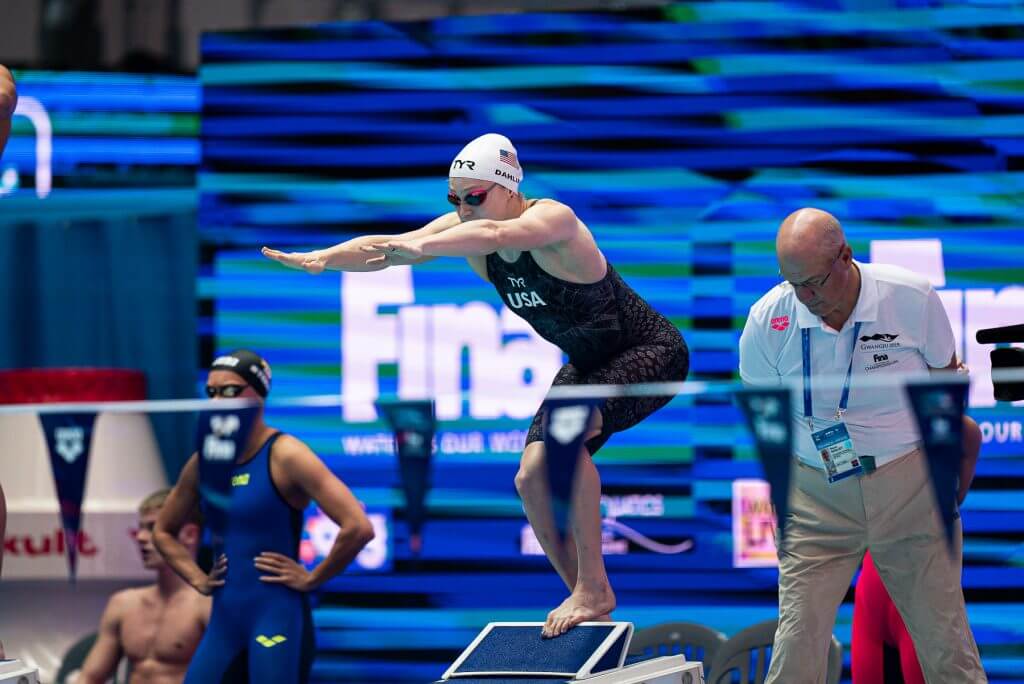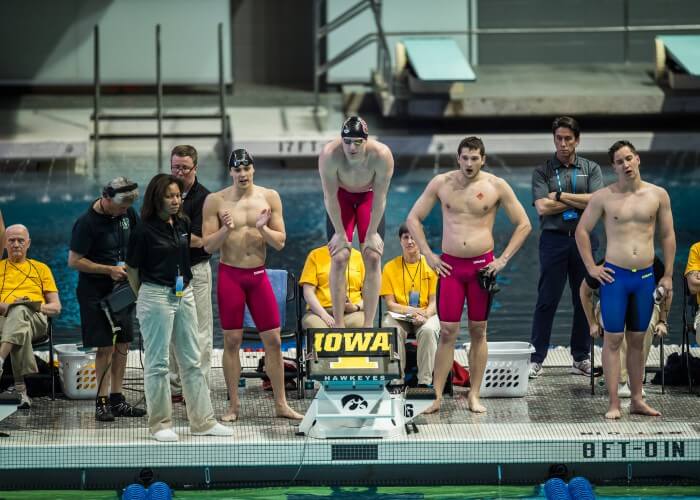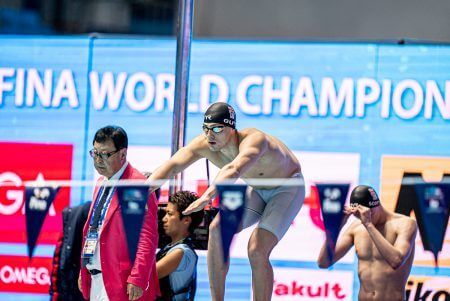Where Did The Step-Over Relay Starts Originate?

The step-over relay starts have become a staple in many swim team’s practice routines. But who was it that started the movement?
As college championship season is starting to get underway this February with conference and then eventually the NCAAs in March, relays will play a huge role in the team standings. Relays provide momentum for the next day, and can make or break a team’s placing in the scores. Relays are important so it is imperative to not make a mistake on the turns, finishes, or the exchanges.
In looking at any of the relays at the conference championships this month, one will notice a common trend in the relay starts from the majority of the teams. The swimmer will hold their arms out in front of them to track the swimmer coming in. They will have their dominant foot sitting behind the wedge on the starting block while the non-dominant foot will be on the wedge. As the swimmer comes in, the one on the block will jump their dominant foot to the front of the block as they dive into the pool, creating momentum and velocity into the water.
In case that was too confusing to read, here is what that looks like as performed by Caeleb Dressel in 2017:
It is a movement that has become the number one way coaches teach relay starts in the United States. Swimming World wanted to track down the origins of the “step-over relay starts” and started with the first place that this author saw them performed at a meet.
The University of Louisville was one of the first schools to perform the relay starts in competition, starting in the fall of 2014.
“Coach Chris (Lindauer) is our sprint guy who really has some of those mindsets and brought the idea early on and we started playing with it with a couple guys,” said Louisville head coach Arthur Albiero. “Clearly we felt it was something that we could continue to get better at. I learned this a long time ago before: if you decide if a new skill is better or worse you need to dominate it and master it and then you can start to compare apples to apples.”
“We weren’t the first to do it,” said Louisville assistant Chris Lindauer. “But we were one of the first waves of teams to do it. I don’t know who started it but we started it probably 5 or 6 years ago. I remember the transition when we converted all of our athletes to it and it was this big process to it because nobody had seen anything like it.”
Going back even further to the 2014 NCAA Championships, which were the first NCAAs to have the wedge blocks, only two schools were doing it consistently then: NC State and Texas.
NC State head coach Braden Holloway said that the idea of a relay start using the wedge started in the summer of 2012.
“My office is next to the sprint track & field coaches and we were talking about our team that just came back from outdoor championships and we were talking about strengths. Getting out of the gates was the most important which is the whole reason they use blocks in track and field,” Holloway said.
“It got me thinking because runners are going in the same startup position we are and we are trying to create as much velocity as we can. So that just started the dialogue of how can we create more velocity off the blocks.”
So that summer in 2012, Holloway had his swimmers experiment with relay starts at small local club meets in North Carolina, and then started performing them in that college season in the fall of 2012.
Then he had eight of his swimmers go to the University of Texas to train, and they shared the idea of the relay starts with them.
“We did a test of it. We did 8x25s of relay exchanges. Four step-over and four of the old two-foot start with 12 people. All of them were quicker to the 15 and to the 25 except one or two times so it made sense to do it,” Holloway said.
Then they started performing them in meets, and it caused a lot of coaches elsewhere to take notice.
“For two straight years we were answering questions about it,” Holloway said. “It was just something new. It was like when Matt Kredich started having his swimmers do a different backstroke breakout. I know I liked the starts and some people think it is gimmicky and don’t want to do it. All blocks are different, so it is just about what is comfortable.”
The step-over relay starts have become something that NC State, and other schools, have mastered, practicing them almost every day at the beginning of each season.
“Originally I thought it was really hard because I didn’t think I was that coordinated,” said current NC State senior Ky-Lee Perry. “It wasn’t easy and it took some time to get it down, but once you get it down, you are good to go. I think you get an advantage because you are using your entire body’s momentum to get off the block, which gets you further in the air with the perfect line.”

Simonas Bilis readying himself up in the 800 free relay at the 2015 NCAAs. Photo Courtesy: Peter H. Bick
“There’s a lot more risk involved and I think that’s what makes the rehearsal the key,” said Louisville’s Albiero. “It’s kind of a team culture. The freshmen come in and that’s one thing, by and large, that they don’t know how to do. We spend some time first couple of weeks of school already, to work on relay starts and understanding the mechanics – not really with anyone swimming into it but just rehearsing the mechanics. And we do that once a week. I prefer that people are a little more aggressive than sitting so we had a couple duel meets this fall where we had some DQ’s. I’m ok with that; it’s just part of the deal at this stage of the season. We are learning how to be aggressive and we don’t want to sit. We want to be smart and we rehearse that.”
“Initially it felt like we were doing them almost every day,” said Louisville’s Lindauer. “There was a point then when even the coaches were coaching themselves with getting familiar with having to deliver this information and watching film. We do a lot of film work and the thing that we are so blessed with today is that you and I have smart phones and the capability to record video. When I was swimming in the early 2000’s no one was really using video review.”
But for a long time, the step-over relay start was only domestic. The United States swimmers were performing the step-over relay start in the 2016 Olympic and 2017 World Championships, most notably Ryan Held in 2016 when he had one of the most beautiful relay starts in the final of the 4×100 free relay. Kelsi Dahlia and Mallory Comerford, both Louisville-based swimmers, were both on the 4×100 free relay gold medal winning team in Budapest in 2017. The team beat Australia by three tenths and all three Americans performed the start, while none of the Aussies did. It may have given them the advantage to come out on top over their rivals.
Other countries have started to integrate the step-over relay start into their practice routine.
Adam Peaty, James Guy and Duncan Scott of Great Britain performed the step-over relay start in the 4×100 medley relay final at World Championships, and they won the gold medal in the process. Germany’s and Sweden’s relays were also doing the same relay starts. The movement has truly gone global.

Great Britain’s James Guy performing the start. Photo Courtesy: Becca Wyant
“It’s cool to see people are willing to share ideas and be thinking outside the box,” Holloway said. “I haven’t really thought about the impact it has had. I remember first noticing when other schools started performing them but other than that I haven’t really thought about it.”
“It’s cool to see it and it makes you as a coach wonder ‘where is the next thing?’ said Lindauer. “We played with positioning whether it is more of a vertical stand-up stance or a flat back hinge at the hip. So we have played with that over the years but it is definitely interesting to see where can we go from here to get better.”
The relay starts have become such an important part of training, that programs are starting to incorporate it into their dryland and weight room training.
“How can we become more athletic? Because that is what you are seeing now: a new wave of swimmer,” said Lindauer. “Look at Dressel. He is certainly tremendously talented in the water but the way he starts and his athleticism is definitely a new wave. And I think you are going to see more of that innovation and capability through technology to really explore that new level of swimming.”
“The sport has to evolve and there’s really limited opportunities for us to evolve,” said Albiero. “The technique is not that different these days. Yeah, people are getting faster so what else can we find? The task is simple: we are trying to go from point A to point B a little bit faster so how do we solve that?”




When they added the fin to the blocks.
The ASCA stroke school course has videos from the 90s/00s recommending the back foot step to front of the block relay exchange. There’s now just something physical to step over.
College teams were doing this even in the late ’90s! Granted, we didn’t have to clear a wedge to get our take-off leg to the front of the block. But this technique in general goes back well before 2012.
I think the whole point of this article is about maximizing power by taking advantage of the wedge. Yes, you can take a step without the wedge but this is really about using the step with the added power of using the wedge to maximize explosiveness off the block.
What’s old is new. We were doing something similar to that in the 60s
John A Sahl
2004 Olympics 4x 100 free relays where SA destroyed USA team
I’d be curious to see wedge vs no wedge for this. The NC State folks tried step-over vs standing, and the step-over is going to be faster in that case no matter what because of the momentum advantage. The wedge should theoretically improve the start further with the added power, but I’d be curious as to how much.
Per my memory, Jimmy Feigen came back from either London in 2012 or Barcelona in 2013 and raves about this new relay exchange method he learned while out there. I believe he picked it up from some swimmers from another country and began teaching it to our guys. Just some more info!
Certainly worth a second look. Maybe I need to re-investigate further 🙂
I thought it was the Longhorns of TC
We did it in the 90s in college.
My boy Daniel Buijs brought it to McKendree that much I know